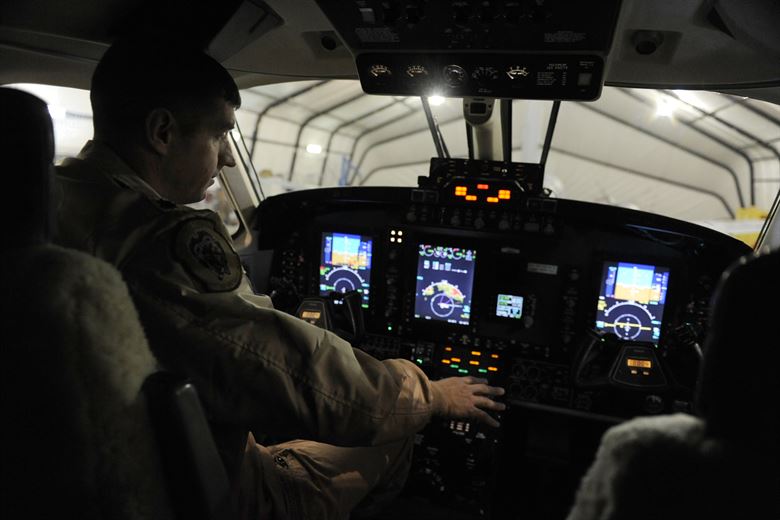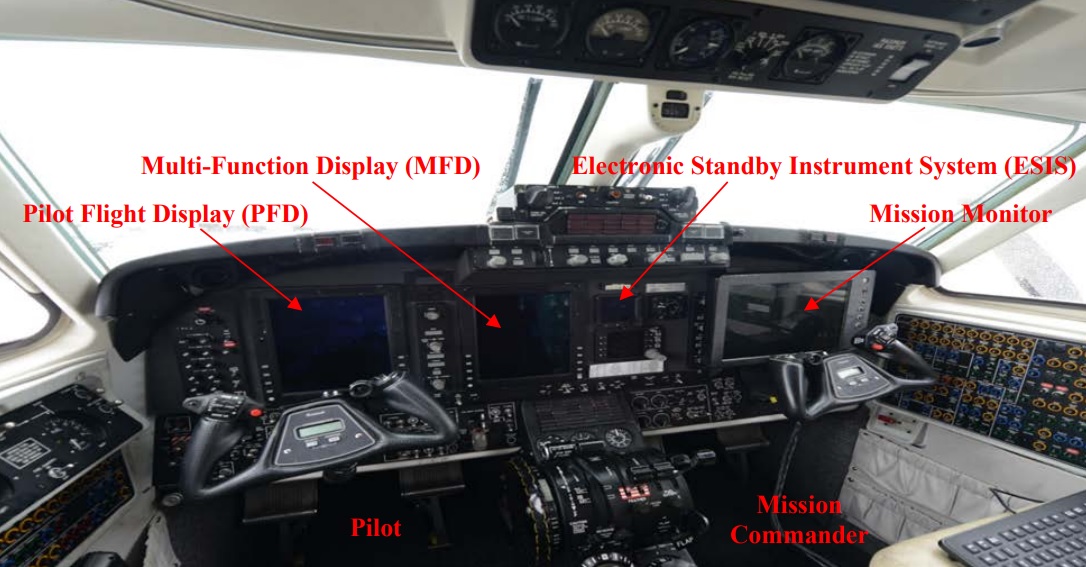When Red Bull Gives You More Than Wings…
A database of US military aviation accidents and incidents complied by Military Times last year revealed an odd mishap. It resulted in website The War Zone submitting a Freedom of Information Act request. The response detailed how the co-pilot of a US Air Force (USAF) Beechcraft MC-12W Liberty King Air 350 10-006450 had reached for refreshment of a flight out of Hurlburt Field, FL on 5 June 2017 (probably on a training flight for US Special Operations Command [SOCOM]). While still holding the unopened 16oz (454ml) can of Red Bull it…
…ruptured spilling fluid onto the center console.
MC-12W Cockpit with Rockwell Collins Pro Line 21 Displays and a Mission Display Deployed in Front of he Mission Commander (Credit: USAF)
While the MCP used his shirt to absorb what he could… He subsequently shut down the mission system power… The crew discussed their options and decided to RTB [return to base].
The cost of this mishap: $113,675 (as 13 avionic Line Replaceable Units [LRUs] had to be replaced), making it a Class C Mishap based on cost.

USAF Beechcraft MC-12W Liberty Cockpit During a System Test in Afghanistan (Credit: USAF / Staff Sgt. Manuel J. Martinez)
The War Zone comment:
The aftermath might have earned them [i.e. the crew] some sort disciplinary action, but Air Force censors redacted the investigating officers’ findings, conclusions, and recommendations.
Its odd that these sections were redacted but disciplinary action might well explain that. Its not clear if the USAF did any safety promotion activity after this event or if there was actually any prohibition in carrying and consuming canned drinks on-board.
Spilt drinks have caused problems before: Fate is Almost the Hunter: United Airlines Pilot’s Spilt Coffee Helps Trigger False Terrorist Alert
UPDATE 12 September 2019: Spilled coffee forces plane to divert over Atlantic (AAIB report)
UPDATE 29 January 2020: A350 engine shutdown incidents linked to cockpit drink spills
UPDATE 25 April 2020: Airbus develops anti-spill cover to protect A350 centre pedestal (an interim fix)
UPDATE 4 September 2020: Airbus redesigns A350 control panel to resist liquid spillage
Its not just drinks: We reported in June 2014 on a Royal Air Force (RAF) A330 Voyager ZZ333, that was involved in a loss of control (LOC-I) incident during a flight to Afghanistan in February 2014. The UK Military Aviation Authority (MAA) issued a preliminary report on 17 March 2014 that said investigators:
…found evidence to link the movement of the seat to the movement of the side-stick, in the form of a Digital SLR camera obstruction which was in-front of the Captain’s left arm rest and behind the base of the Captain’s side-stick at the time of the event. Analysis of the camera has confirmed that it was being used in the three minutes leading up to the event. Furthermore, forensic analysis of damage to the body of the camera indicates that it experienced a significant compression against the base of the side-stick, consistent with having been jammed between the arm rest and the side-stick unit.
The full Service Inquiry (SI) report has since been published.
MC-12W Liberty Background
The US Air Force (USAF) MC-12W Liberty programme was started in 2008 to field an immediate Intelligence, Surveillance and Reconnaissance (ISR) capability for Iraq and Afghanistan and went from contract to first combat sortie in just 8 months, by modifying the KA350. These KA350s had the Rockwell Collins Pro Line 21 cockpit avionics system.
The MC-12W programme was reportedly named ‘Project Liberty’ “as a homage to the World War II-era Liberty Ship programme” of mass produced merchantmen. The mission systems were integrated by L-3 Communications, with 22,000 man hours needed for each conversion. The first combat mission was undertaken in Iraq on 10 June 2009. The $1 billion MC-12W procurement was intended to fill an ISR gap by providing full-motion video and signals intelligence data in real-time down to the ground troops.
However, in 2015 11 were transferred to the US Army and 26 to SOCOM.
Since its first combat mission on 10 June, 2009, the MC-12 community has flown 400,000 combat hours and participated in 79,000 combat sorties, the [USAF] says. In November 2014, the air force reported that MC-12 crews had aided in the kill or capture of “more than 8,000 terrorists”, and uncovered 650 weapons caches.
Safety Resources
We have previously published a case study on USAF MC-12W 09-0676, of the 361st Expeditionary Reconnaissance Squadron (361 ERS), that suffered as Loss of Control – Inflight (LOC-I) and crashed 110 miles northeast of Kandahar, Afghanistan 27 April 2013 during a combat ISR mission.
Other articles include:
- Professor James Reason’s 12 Principles of Error Management
- Back to the Future: Error Management
- USMC CH-53E Readiness Crisis and Mid Air Collision Catastrophe
- AC-130J Prototype Written-Off After Flight Test LOC-I Overstress
- C-130J Control Restriction Accident, Jalalabad
- Investigation into F-22A Take Off Accident Highlights a Cultural Issue
- USAF Engine Shop in “Disarray” with a “Method of the Madness”: F-16CM Engine Fire
- Inadequate Maintenance, An Engine Failure and Mishandling: Crash of a USAF WC-130H
- Inadequate Maintenance at a USAF Depot Featured in Fatal USMC KC-130T Accident
- USAF Parachutist Fatally Extracted Through Ventilation Door
- USAF T-38C Downed by Bird Strike
- Contaminated Oxygen on ‘Air Force One’




Recent Comments